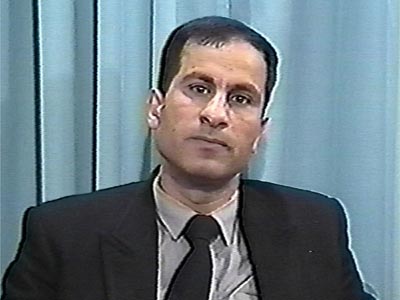Despite his radical leanings, after his discharge Mohamed landed a job as an Egypt Airlines executive. There, he’d learn how to exploit security then share the information with men who’d strike the World Trade Center and Pentagon almost a quarter century later.
Mohamed formally introduced himself to America in 1984 when he offered his services to the CIA in Cairo. Assuming he was an Egyptian spy, they accepted him as a junior intelligence officer. His first assignment:infiltrate a German mosque with ties to Hezbollah. Instead, Mohamed informed the cleric he was an American spy. They didn’t know there was already a spy in the congregation and he was reported.
The CIA fired Mohamed then sought to ban him from entering the US. It was too late. He’d already flown to California on a passport they sponsored. Along the way he met an American woman. Just six weeks later they married.
Now in California, Mohamed became a citizen then joined the US Army. He was soon stationed at Fort Bragg where he joined the Green Berets. His evaluations found him, “beyond reproach and consistently accomplished.” His superiors even encouraged him to pursue a doctorate in Islamic Studies and teach courses on the Middle East to the military.
Little did they know Mohamed was in constant contact with Ayman al-Zawahiri, a radical Egyptian doctor who’d later become al-Queda’s number two under bin Laden.
1986: Soviet forces were bogged down in the Afghan quagmire. Much to everyone’s surprise, the Mujahideen was holding back the best the superpower had to offer. Covertly backed by the CIA who was seeking payback for Soviet support of the Vietcong during Vietnam, the rag tag group had brought the Soviet Army to a standstill.
Back at Fort Bragg, Sergeant Mohamed requested to travel to Afghanistan to assist the Mujahideen. Fearing not only the loss of a soldier’s life but an international incident if the Soviets ever found out, his request was denied. Nevertheless, Mohamed took leave, flew to Afghanistan then opened a bin Laden financed training base. If that wasn’t brazen enough, Mohamed returned with equipment captured from dead Soviet’s and presented them to his superiors.
Lt. Col. Robert Anderson later said he wrote detailed reports to Army intelligence requesting an investigation. He was ignored. He recalled, "We’d have a better chance of winning the Powerball than an Egyptian major in the unit that assassinated Sadat would have getting into the Army and assigned to the Special Forces. It was equally unthinkable an ordinary soldier would go unpunished after fighting in a foreign war.”
When his enlistment ended, Mohamed moved to New York City to teach demolition at the Al Kifah Refugee Center. His expertise helped El Sayyid Nosair and Mahmud Abouhalima, conspirators in the 1993 World Trade Center bombing that left 6 dead and more than 1000 injured.
Mohamed also traveled to Kenya to survey embassies. His intel ultimately helped Al-Qaeda bomb the Nairobi embassy.
Despite his successes, al-Qadea was growing suspicious. Suspecting a double agent, the terrorist group went so far as to not share identities of other al-Qadea operatives. They were right. Mohamed had been working as an FBI informant since 1990.
But just because Mohamed was working with the FBI didn’t mean they were happy. Retired agent Joseph O’Brien complained, “The most unbelievable aspect is we didn’t polygraph him. The first thing you do with an informant is polygraph him and then continue to polygraph him down the line.”
What he didn’t know was Mohamed was polygraphed in 1993and had failed. By then he was a year into training terrorists in Afghanistan, Sudan and Bosnia.
Sponsored by a Newark New Jersey mosque, in 1993 Mohamed formed a 14-man team of retired US military to enter Bosnia to assist the Mujaheddin. According to the Associated Press, twelve men left within two months. Mohamed and another American, Abu Musa, stayed to help attack behind Serb lines.
By 1995 Mohamed was back in the US where he applied for a security clearance to become a guard with a US defense contractor. In his application he never mentioned the Mujaheddin.
The Defense Department conducted a background check and interviewed him multiple times. Mohamed claimed he never belonged to a terrorist organization, but had been approached by organizations that could be called terrorist.
His clearance was denied however he still landed the job. While working in Sunnyvale for Northrop-Grumman - a Trident missile contractor - Mohamed had physical access to a computer containing classified information. It was never ascertained if he actually got into it.
By 1998, the US government had connected enough dots to indict Mohamed. He subsequently pled guilty to the Nairobi embassy bombing with sentencing set for July 2001. Then nothing happened. Sources suggest Mohamed was providing information and sentencing was indefinitely postponed. The federal government will neither confirm nor deny the rumor.
In 2006 Mohamed’s wife, Linda Sanchez, commented, “He’s still not sentenced and without that I can’t say much. He can’t talk to anybody. Nobody can get to him. It’s like he just vanished into thin air.”
As recently as 2011, Mohamed hadn’t been sentenced. Some have called him a “Ghost detainee” – a prisoner whose identity’s been hidden by keeping them unregistered and therefore anonymous.

The Terrorist We Made
September 2001. As our military prepared a response to 09/11, American intelligence began hunting the individuals responsible our worst terror attack. The search would ultimately take years and lead to far ends of the earth. However, a key player was not just the highly publicized terrorist Osama bin Laden but an American citizen who once served as a former US Army special-forces sergeant, as well as an informant to the FBI and CIA.
Ali Abdul Saoud Mohamed was born in Egypt in 1952. At six one and 200 pounds, he was exceptionally fit. He spoke fluent English, French, Hebrew and Arabic and was a skilled martial artist. As a major in the Egyptian Army, his evaluations noted he was “disciplined, clever, and gregarious with a marked facility for making friends.”
Mohamed served in army intelligence until 1984 when he was discharged for fundamentalism. It wasn’t a stretch. Some unit members had participated in the 1981 assassination of President Anwar Sadat.


The CRIME FILES
